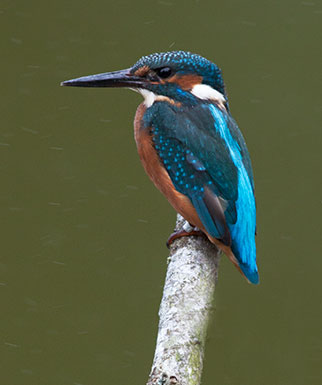Kingfisher (Alcedo atthis)
When: Usually from March to September
How many: Relatively small numbers

the New Forest crown
How fitting that this bird should once have been known as the Halcyon, for sightings of kingfishers certainly make for halcyon days.
In flight, flashes of bright blue, turquoise, orange and white attract attention, but at rest, the kingfisher’s relatively small size - not much bigger than a robin – helps the birds remain unnoticed even when perched in the open on overhanging branches, ready at any time to dive for fish.
Presence, though, is often betrayed by a far-carrying, shrill whistle used as an alarm call and also as a warning to other kingfishers that territory is occupied.
On busily whirring wings, kingfisher flight is fast and direct, whilst the long bill and torpedo-shaped body are distinctive as the bird passes by, usually low over the water. Kingfishers will, however, when occasion warrants, over-fly the tree tops, and cut corners over land to by-pass meanders in the stream.
Kingfishers breed in the New Forest, but do not usually over-winter – presumably fish stocks in the acid waters are insufficient for their needs. But winter kingfisher sightings do occur around the New Forest margins, including at garden ponds that offer the prospect of a quick, easily caught snack.
Arrival on the breeding grounds is from early March, whilst most kingfishers are gone by late summer or early autumn. Returns to the adjacent coast are often noticed in late July and August, and numbers there subsequently, progressively increase.
Quite high, steep banks are usually required as kingfisher nest sites, and in the New Forest, most of these occur in the woodlands. But immediately before and after the breeding season, kingfishers may be seen along any of the New Forest streams or on local areas of standing water.
Suitable nest banks, though, are not particularly abundant, so here, only a relatively small population of kingfishers can be accommodated. Indeed, despite almost inevitable Victorian persecution and the kingfisher’s susceptibility to hard winters, underlying numbers today may not be much changed from those of the mid-19th century when John Wise wrote: ‘Not very common, yet it may now and then be seen at Darrat’s stream, near Lyndhurst, the brook in the Queen’s Bower Wood, and the Osmanby Ford river, near Wootton.’
Up to a metre (39 inches) in length, kingfisher tunnels are often sited relatively high in the bank so as to reduce the risk of flooding, and are also usually inclined slightly upwards from the entrance which assists drainage and avoids rainwater in-flow.
Flooding, though, is not the only cause of nest failure. Visitors to the New Forest find the streams and rivers attractive, particularly during early and late-May Bank Holidays when it’s not unusual to see families picnicking on top of kingfisher nest banks or using rope swings slung from overhanging boughs. Sadly, all too often, the consequences are inevitable – a kingfisher clutch or brood deserted by frightened parents.
Occupied kingfisher tunnels late in the breeding season, and previously used tunnels, are often readily detected – unfledged youngsters have a habit of defecating in the tunnel, always towards the source of light, leaving the resultant mess to flow down the nest bank in a nutrient-rich seam that often eventually encourages a growth of mosses.
References:
Collins Bird Guide: Killian Mullarney, Lars Svensson, Dan Zetterstrom and Peter J.Grant
Birds of Hampshire: Hampshire Ornithological Society
Hampshire Bird Reports: Hampshire Ornithological Society
The New Forest: Its History and Scenery: John R. Wise.
British Birds in their Haunts: Rev. C.A. Johns
More links
Other related links
Search this site

Sadly, 58 animals were killed - 35 ponies, 13 cows, 8 donkeys and 2 sheep, whilst a further 32 were injured - 3 pigs, 9 donkeys, 11 cows and 9 ponies.
(Forty-three accidents occurred in daylight, 15 at twilight and 101 in the dark. Twenty-seven accidents were not reported by the driver involved).
Here's just one horrific example - Three donkeys killed in collision with van at notorious New Forest blackspot (Advertiser and Times)

